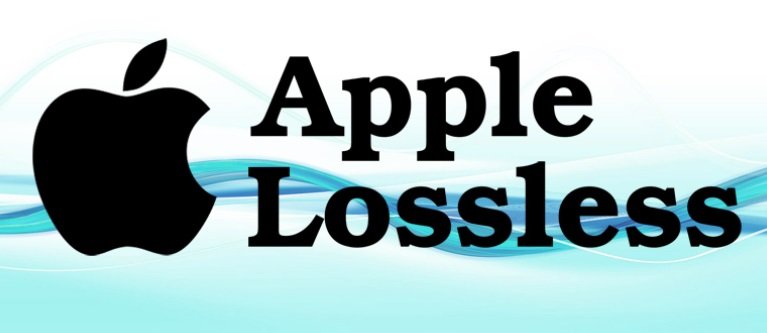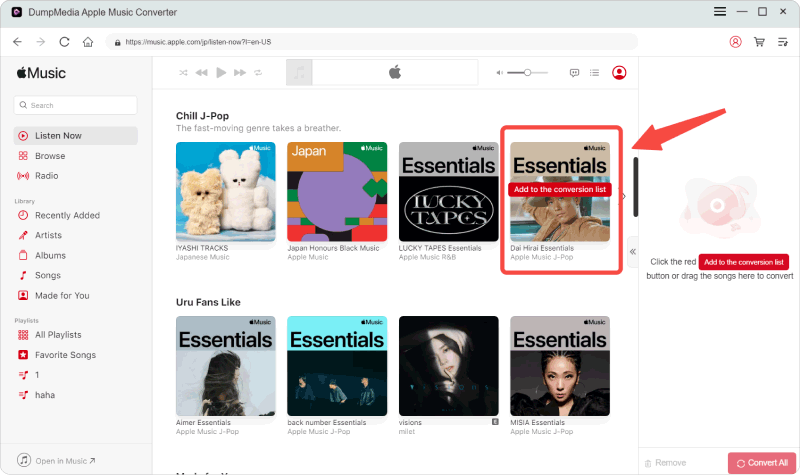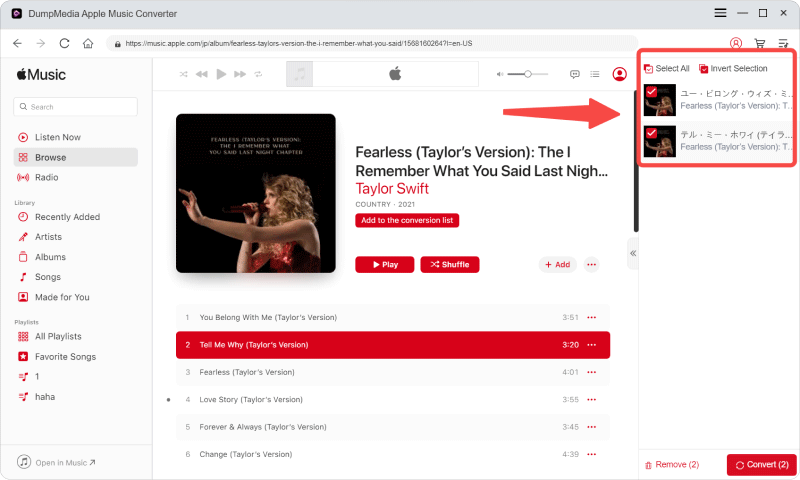
High-quality audio has become important in our world where we consume music and other forms of audio. Whether we are listening to our favorite songs on our smartphones, streaming music on our laptops, or watching movies in our home theaters, we all want the best possible listening experience.
Lossless audio is a type of audio format that has gained popularity in recent years, especially among audiophiles and music enthusiasts. Unlike other audio formats that use lossy compression techniques, which result in some level of quality loss, lossless audio formats such as Apple Lossless offer an uncompressed, high-quality listening experience.
In this article, we will explore what Apple Lossless is and how it works, as well as its advantages and disadvantages. We will also discuss how to use Apple Lossless and help you determine whether it is the right choice for your audio needs.

Contents Guide Part 1. What Is Apple Lossless?Part 2. Pros And Cons Of Apple LosslessPart 3. Apple Lossless Vs. Other FormatsPart 4. Bonus Tip: Grab Apple Music In High-Quality Output FilesPart 5. Conclusion
Apple Lossless, also known as Apple Lossless Audio Codec (ALAC), is a lossless audio compression format developed by Apple Inc. It was introduced in 2004 and is now widely supported by Apple's devices, software, and services.
The purpose of Apple Lossless is to compress audio files without sacrificing any of the original audio data or quality. Unlike other lossy audio compression formats such as MP3 and AAC, which use a method of removing audio data to reduce file size, Apple Lossless retains all the original audio data, making it an ideal choice for those who want to maintain the highest level of audio quality.
When compared to other audio formats, such as MP3 and WAV, Apple Lossless offers a better listening experience due to its ability to retain all the original audio data. MP3, for example, is a popular lossy audio format that uses compression techniques to remove audio data, resulting in a smaller file size but also a loss in audio quality. WAV, on the other hand, is an uncompressed audio format that offers high-quality audio but has a much larger file size compared to Apple Lossless. In comparison, Apple Lossless provides the best of both worlds - compressed file sizes without any loss in audio quality.
Apple Lossless uses a type of compression called "lossless" compression, which means that it compresses audio data in a way that does not lose any of the original data. This is different from "lossy" compression used by other audio formats like MP3, which sacrifices some of the audio data to achieve a smaller file size.
The technical process of Apple Lossless compression involves breaking down the original audio data into smaller "frames" that can be analyzed and compressed individually. These frames are then compressed using a technique called "prediction," where the compressed data is predicted from the previous data in the frame, and the difference between the two is then stored. This process is then repeated until the entire audio file is compressed.
The compression algorithm used by Apple Lossless is efficient in reducing the file size without compromising on the audio quality. The compressed data can be decompressed by any device that supports Apple Lossless, and the audio quality is fully restored to the original quality.
One of the key features of Apple's Lossless is its ability to preserve the original audio quality while reducing the file size. This is achieved through the use of lossless compression, which ensures that no audio data is lost during the compression process. As a result, the audio quality of the compressed file is identical to that of the original uncompressed audio. This makes Apple Lossless a popular choice for those who want to maintain the highest level of audio quality while still keeping their audio files at a manageable file size.
Improved Sound Quality
Apple Lossless provides a significant improvement in audio quality over lossy audio formats like MP3, AAC, and others. The format offers a bit-for-bit reproduction of the original audio data, ensuring that no audio quality is lost during the compression process. This means that you get the best possible sound quality for your music, podcasts, or other audio content.
Wide Compatibility
Apple Lossless is widely supported by Apple devices, software, and services. This means that you can use the format with your Apple TV, iPhone, iPad, Mac, and other Apple products. It also means that you can easily stream or share your music without worrying about compatibility issues.
Smaller File Sizes
Although Apple Lossless is a lossless audio format, it can still provide smaller file sizes compared to other lossless audio formats like FLAC. This is due to the advanced compression algorithm used by Apple Lossless, which ensures that the compressed file size is as small as possible without compromising on the audio quality.
Easy to Use
Apple Lossless is easy to use and can be used with various Apple devices and software. You can easily convert your existing audio files to the Apple Lossless format using iTunes or other software, and the format can also be used with popular music streaming services like Apple Music.
Larger File Sizes
One of the main disadvantages of Apple Lossless is that it produces larger file sizes compared to lossy audio formats like MP3 or AAC. This is because the lossless compression algorithm used by Apple Lossless is not as efficient as the lossy compression algorithms used by these other formats. This may be a consideration if you have limited storage space on your device or if you want to stream your audio files over a slow or limited internet connection.
Limited Compatibility
Although Apple Lossless is widely supported by Apple devices and software, it may not be as compatible with non-Apple devices or software. This may make it difficult to share or transfer your audio files with others who do not use Apple products.
Processing Power
Apple Lossless requires more processing power to encode and decode audio files than lossy audio formats like MP3. This may result in longer encoding times or slower playback on older or less powerful devices.
One of the main competitors to Apple Lossless is the FLAC (Free Lossless Audio Codec) format. FLAC is an open-source lossless audio format that is widely used by audiophiles and music enthusiasts. In terms of sound quality, both Apple Lossless and FLAC offer similar performance as they are both lossless audio formats. However, there are some differences between the two formats, such as:
In comparison to lossy audio formats like MP3 or AAC, Apple Lossless offers several advantages in terms of sound quality and fidelity. However, it also has some disadvantages, such as larger file sizes and limited compatibility, that may make it less suitable for some users. Some of the main differences between Apple Lossless and lossy audio formats like MP3 are:
As a bonus tip, we will talk about DumpMedia Apple Music Converter. This is a great tool that will help you grab your tracks from Apple Music. It can help you get the tracks in high-quality output files without losing metadata and ID3 tags.
Also, you may download songs from Apple Music and use them as SMS ringtones, commute music, and more. You'll need a program named DumpMedia Apple Music Converter to accomplish that. You may use it to download your preferred Apple Music tracks, including songs, instrumentals, podcasts, and more.
These are the steps to use DumpMedia Apple Music Converter to extract your favorite tracks from Apple Music:

3. Choose the output format you desire. The available options include MP3, M4A, WAV, FLAC, and more.
4. Select the destination folder where you want to save the converted files.
5. Click the "CONVERT" button to begin the process of extracting the tracks and converting them to your desired format.
6. Once the conversion is complete, the converted tracks will be available in the destination folder you selected. You can now transfer them to other devices like iPhones, Android devices, smartwatches, USB flash drives, or other computers, as needed.

In conclusion, Apple Lossless is a high-quality audio format that provides a significant improvement in sound quality compared to lossy formats such as MP3. While it has some disadvantages such as larger file sizes, the benefits of using Apple Lossless include retaining the original quality of the audio and compatibility with a wide range of Apple devices and software.
Speaking of Apple Lossless, you can also use DumpMedia Apple Music Converter to grab your favorite tracks from Apple Music ensuring that there’s a high-quality output file with you. You can get the tool at DumpMedia.com today!
